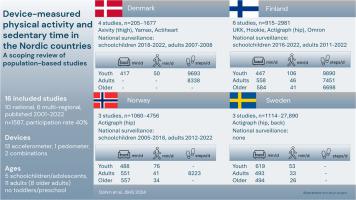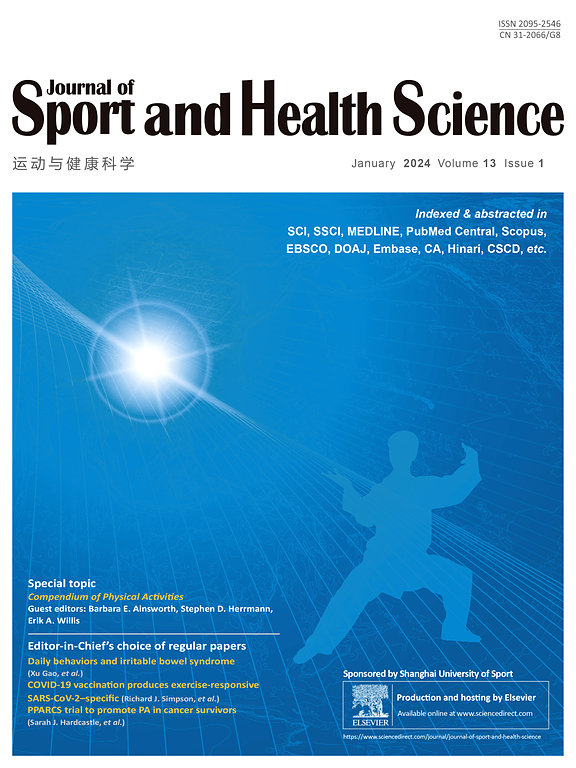北欧国家通过设备测量的体力活动和久坐时间:基于人口的研究的范围界定审查
IF 10.3
1区 医学
Q1 HOSPITALITY, LEISURE, SPORT & TOURISM
引用次数: 0
摘要
本范围综述旨在总结和描述北欧国家(丹麦、芬兰、冰岛、挪威和瑞典)2000 年或之后发表的基于人群的体力活动和久坐时间的研究方法和结果。2023 年 6 月,我们使用预定义的搜索条件在 PubMed 和 Web of Science 上进行了系统搜索。共发现了 14 项独特的研究项目或监测研究。此外,还纳入了 2 项由国家机构发布的监测研究,因此共纳入了 16 项研究。芬兰和挪威拥有国家监测系统,定期对学龄儿童/青少年和成年人进行调查。丹麦最近只收集了学龄儿童的全国代表性数据。到目前为止,瑞典还没有使用设备收集数据的定期国家监测系统。冰岛没有相关研究。第一项研究是在 2001 年进行的,最近的一项研究是在 2022 年进行的,大部分数据是在 2016 年至今收集的。五项研究包括 6-18 岁的儿童/青少年,没有研究包括学龄前儿童。共有 11 项研究包括成年人,其中 8 项研究还包括老年人。没有研究专门针对老年人。分析样本量从 205 个到 27 890 个不等。研究介绍了详细的方法,如取样策略、设备类型和位置、佩戴协议和体力活动分类计划等信息。报告介绍了北欧国家儿童/青少年、成年人和老年人的体力活动水平和久坐时间。在北欧国家,基于设备的体力活动和久坐行为人口监测的实施情况日益增多。北欧国家内部和国家之间的设备、位置和数据程序各不相同,这凸显了在比较研究结果时所面临的挑战,以及需要更加标准化的数据收集。本文章由计算机程序翻译,如有差异,请以英文原文为准。

Device-measured physical activity and sedentary time in the Nordic countries: A scoping review of population-based studies
The purpose of this scoping review was to summarize and describe the methodology and results from population-based studies of physical activity and sedentary time measured with devices in the Nordic countries (Denmark, Finland, Iceland, Norway, and Sweden) and published in 2000 or later. A systematic search was carried out in PubMed and Web of Science in June 2023 using predefined search terms. Fourteen unique research projects or surveillance studies were identified. Additionally, 2 surveillance studies published by national agencies were included, resulting in a total of 16 studies for inclusion. National surveillance systems exist in Finland and Norway, with regular survey waves in school-aged children/adolescents and adults. In Denmark, recent nationally representative data have been collected in school children only. So far, Sweden has no regular national surveillance system using device-based data collection. No studies were found from Iceland. The first study was conducted in 2001 and the most recent in 2022, with most data collected from 2016 to date. Five studies included children/adolescents 6–18 years, no study included preschoolers. In total 11 studies included adults, of which 8 also covered older adults. No study focused specifically on older adults. The analytical sample size ranged from 205 to 27,890. Detailed methodology is presented, such as information on sampling strategy, device type and placement, wear protocols, and physical activity classification schemes. Levels of physical activity and sedentary time in children/adolescents, adults, and older adults across the Nordic countries are presented. A growing implementation of device-based population surveillance of physical activity and sedentary behavior in the Nordic countries has been identified. The variety of devices, placement, and data procedures both within and between the Nordic countries highlights the challenges when it comes to comparing study outcomes as well as the need for more standardized data collection.
求助全文
通过发布文献求助,成功后即可免费获取论文全文。
去求助
来源期刊

Journal of Sport and Health Science
SPORT SCIENCES-
CiteScore
18.30
自引率
1.70%
发文量
101
审稿时长
22 weeks
期刊介绍:
The Journal of Sport and Health Science (JSHS) is an international, multidisciplinary journal that aims to advance the fields of sport, exercise, physical activity, and health sciences. Published by Elsevier B.V. on behalf of Shanghai University of Sport, JSHS is dedicated to promoting original and impactful research, as well as topical reviews, editorials, opinions, and commentary papers.
With a focus on physical and mental health, injury and disease prevention, traditional Chinese exercise, and human performance, JSHS offers a platform for scholars and researchers to share their findings and contribute to the advancement of these fields. Our journal is peer-reviewed, ensuring that all published works meet the highest academic standards.
Supported by a carefully selected international editorial board, JSHS upholds impeccable integrity and provides an efficient publication platform. We invite submissions from scholars and researchers worldwide, and we are committed to disseminating insightful and influential research in the field of sport and health science.
 求助内容:
求助内容: 应助结果提醒方式:
应助结果提醒方式:


